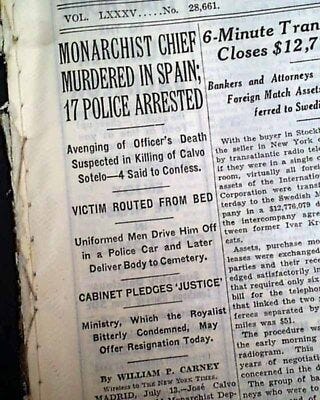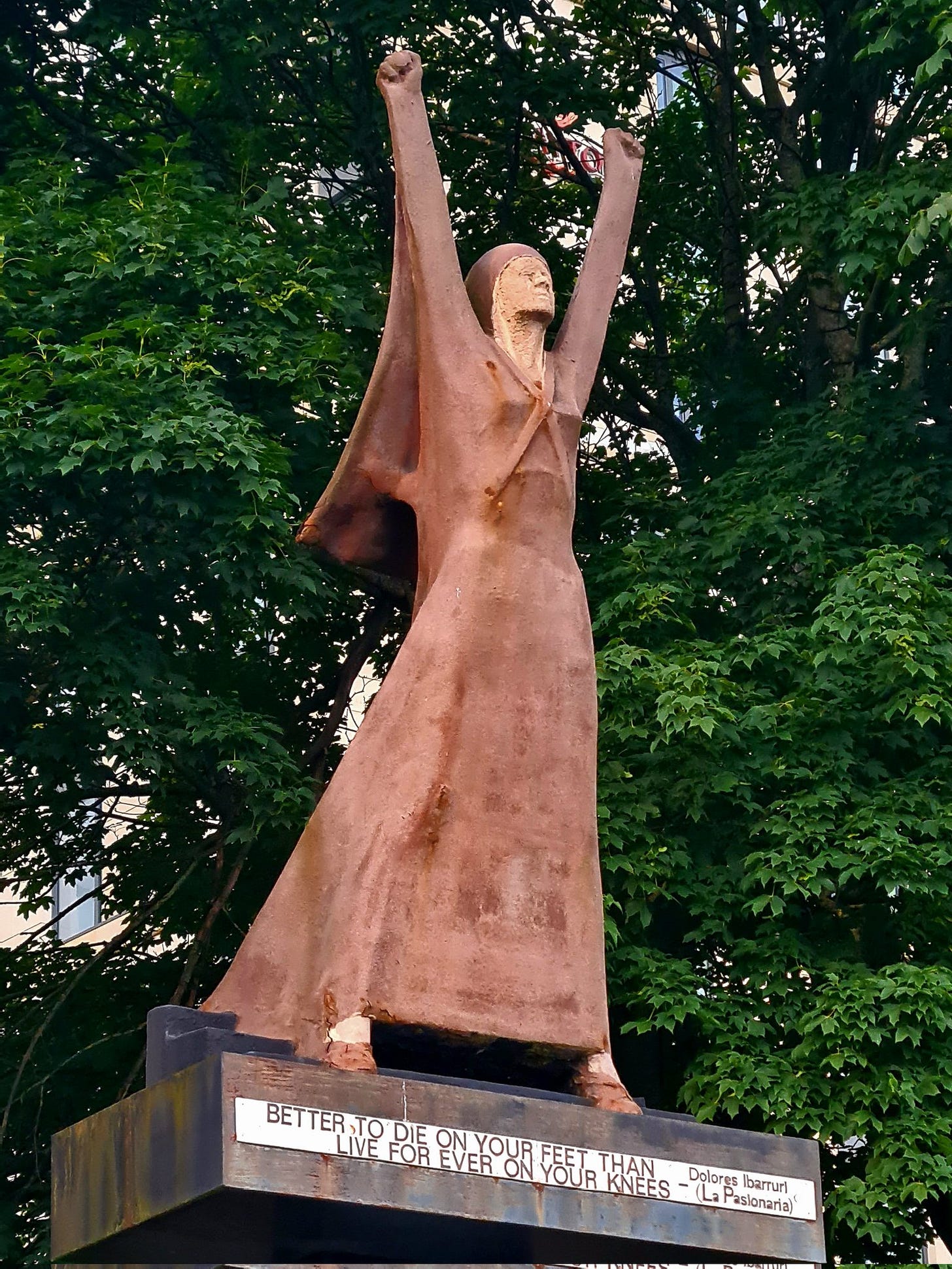Upbeat Songs to Stalinist War Criminals: Spain's Dolores Ibárruri
Dolores Ibárruri was a wretch of a woman.
The shitlibs call her "La Pasionaria" as a way to soften the fact that her militant Stalinism is her most attractive feature. The phrase means “the passion flower.”
Nature thankfully gives us warning symbols for things that are dangerous and toxic.
And one graceful thing that nature provides us, is that it makes left-wing women hideously ugly both inside and out. They are so resoundingly dysgenic that you can never be confused with what you’re dealing with.
Dolores profaned Catholicism by calling herself the ‘Pasionaria’

The passionflower is associated with the Passion of Jesus Christ—the suffering and crucifixion of Jesus—because its various parts represent aspects of the crucifixion:
The flower itself: The structure of the flower symbolizes the crown of thorns worn by Jesus.
The ten petals and sepals: These can represent the ten apostles who were faithful to Christ during his Passion, excluding Judas Iscariot.
The stamens: Often interpreted as the three nails used in the crucifixion.
The spiraled tendrils: Symbolizing the whips used to scourge Jesus.
Ibárruri was only passionate about Communism and Stalinism.
She was nothing but a steaming pile of shit.
Five of her six children died before their second birthday. Her only son died fighting at Stalingrad in 1942.
ChatGPT will lie to you and say she was not a war criminal. It will also try and hide the following information from you.
Yet she was a war criminal and an awful person.
She specifically called out the assassination of a Spanish monarchist, Calvo Sotelo.

Sotelo was born on March 6, 1893, and became known as an advocate for monarchism. He was associated with the Spanish Renovation Party (Partido Renovación Española) and later became a prominent figure in the coalition of right-wing forces opposing the Second Spanish Republic.
During the Spanish parliamentary session on June 17, 1936, Ibárruri said, directed at Sotelo:
"Señor Calvo Sotelo, I am going to say to you that this will be your last speech. You have made many in the past, and they have all been the same: a miserable condemnation of the workers and their organizations. You will no longer have a chance to speak against the Republic."
Sotelo would be dead less than a month later, murdered by leftist police officers in the early morning of July 13, 1936.
She was angry because Sotelo had pointed out the failures of the Spanish left-wing government. Sotelo had pointed out the left-wing failures and then closed with, among other things, the following:
"I say what Santo Domingo de Silos replied to a Castilian king: ‘Lord, you can take my life but you cannot do more. And it is preferable to die with glory than to live with vilification.'"
He paid for his dissident opinions with his life.
Left-wing police would come to his door and ask him to come with, asking him to sit in the third row of the car below.
Sotelo’s body was dumped in the street in front of the morgue.
What’s amazing is that academics will not blame Ibárruri for calling her shot.
Instead, they ignore the statement by Ibárruri altogether.
Some left academics like Antony Beevor, in his classic “The Battle for Spain” ignores the Sotelo murder altogether. The index for the book skips right over Sotelo and goes from Soria to Soviet Union. But Beevor goes into detail about Ibárruri’s good deeds, her love life, leading recruitment campaigns, farewell speech, and life after Spain. Beevor is considered a “center-right” historian for context.
While acknowledging that Sotelo’s death is considered the spark that set off the Spanish Civil War, other academics blame the murder of Sotelo on the murder of left-wing Jose Castillo the night before.
Castillo was a left-wing police officer who was murdered on July 12, 1936.

Castillo was killed because he was blamed for the murder of Andrés Sáez de Heredia, who was related to the leader of the fascist Falangist leader José Antonio Primo de Rivera.
Castillo was the leader of a militant guard force called “La Motorizada” which translates to “the Motorized” which was a motorcycle gang that protected left-wing politicians. Castillo and his men shot up a funeral procession and one of the shots killed Heredia.
Heredia had been killed during this military funeral parade on April 14, 1936 in the streets of Madrid. The funeral was for Anastasio de los Reyes.
Anastasio de los Reyes was a civil guard who had been policing the celebration on April 14, 1936, the fifth anniversary of the Spanish Second Republic.
Both the political right and left later claimed Reyes as one of their own.
The Spanish second Republic, after they displaced the monarchy, is split into three short periods. The first period, the Anzana government, was left-socialist. The second period, which featured a slightly more moderate CEDA Catholic centrist leftism, ruled for two years, until it was finally replaced in 1936 by the “Popular Front” which pretended to be a diverse coalition of left-wing interests but was, in fact, nothing but concealed Communism.
These spiraling murders paved the way for the Spanish Civil War as the country became unmoored to any sense of law and order.
Neither Sotelo or Castillo’s murderers were ever brought to justice.
The police killed Sotelo after arresting him and saying that they were going to bring him to the station for questions. Instead, they shot him in the back of the head like the cowards that they still are.
Luis Cuenca Estevas, a member of the PSOE youth and "La Motorizada", fired a shot in the neck of the deputy, the bullet exiting through the left eye.
The Communist response to the Sotelo killing was to force the assigned judge off the case. Then they demanded that several right wing groups be shut down, and right-wing newspapers be confiscated. They did this in the areas they controlled.
When the left assassinated someone on the right, the left’s response was to officially, judicially, further, continue punishing the right.
This is what justice looks like in left-wing countries: a total inversion of natural law and morality.
As further proof that Castillo’s murder had little to do with Sotelo’s, Sotelo was found to have been complaining that the government instructed his escorts and security guards to run away if there was a gunfight or altercation sometime soon.
Sotelo was killed, and the left-wing government planned it, capitalized upon it, and rejoiced in it. They ensured that his killers would go unpunished, and their darling passionflower was so degenerate as to publicly gloat about it in parliament.
And now 90 years later, the left is still lying about it in a variety of ways.
To that end, the left has made a sweet-sounding song about the life of Dolores Ibárruri. You can find it easily on YouTube.
The same platform refuses to allow instrumental music that might be too right-wing, but it allows this glorification of this monster.
After Franco came to power, Ibárruri fled to the Soviet Union, where she stayed until February 15, 1977 when she returned. Prior to returning, and upon disembarking, she complained about not having a pension from the Spanish government. She was given one, and lived out her life on the public dole until her death at age 93 on November 12, 1989, three days after the Berlin Wall was opened.
In 1960, Franco constructed a memorial to Sotelo in Madrid that still stands. The left no doubt made sure that it was eclipsed by buildings nearby.
The memorial was slightly moved in 1992 during renovations.
No doubt it won’t be with us long, as for the left there is never a nit too small to pick.
Meanwhile, they push out their garbage whitewash cultural trash and academic trash to cover up their crimes.
It’s a little surreal to listen to songs to war criminals on YouTube, but here we are.
ORIGINAL LYRICS:
Sí, veremos a Dolores caminar
Las calles de Madrid
Quién te puede negar
Si el tiempo transcurriendo confirmó
Que esto no daba más
Y que era inevitable la reconciliación
Se gastan las palabras
Golpeando contra el muro
Pero ahí están las tuyas
Cargadas de futuro
Quién te puede negar
No hay tregua en el combate por la paz
Desde el cincuenta y seis
Tendimos nuestra mano a todos los demás
Bandera infatigablе
Del hombre acorralado
De un puеblo que no quiere
Vivir amordazado
Quién nos puede negar
Porque nos regatean respirar
Quién se atreve a explicar
Que sea un beneficio la clandestinidad
Para otros los laureles
La regalada historia
Que el único camino
Nos lleve a la victoria
ENGLISH TRANSLATION:
Yes, we will see Dolores walk
The streets of MadridWho can deny you
If time passing confirmed
That this couldn't go on
And that reconciliation was inevitable?
Words are spent
Banging against the wall
But there are yours
Loaded with the futureWho can deny you?
There is no truce in the fight for peace
Since fifty-six
We extended our hand to everyone else
Tireless flag
Of the cornered man
Of a people that doesn't want
To live gaggedWho can deny us?
Because they haggle over our right to breathe
Who dares to explain
That being underground is a benefit?
For others, the laurels
The gifted history
That the only path
Leads us to victory.
In her life she went from “They shall not pass!” to “Please give me a pension after being on the losing side of a Civil War I started.”
Ibárruri is buried in the Catholic Almudena Cemetery in Madrid.
There is a memorial to this monster in Glasgow, Scotland because Communism is a virus that exists everywhere.
In 2019 someone vandalized her grave. It wasn’t me.



















